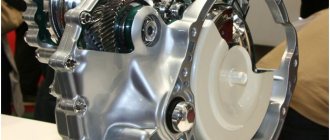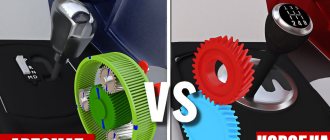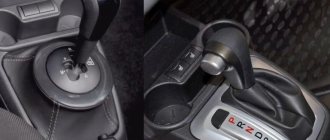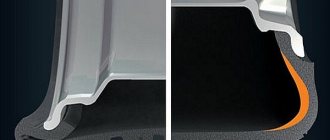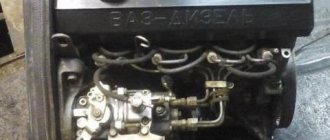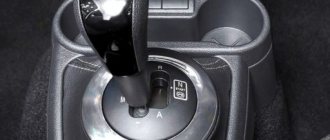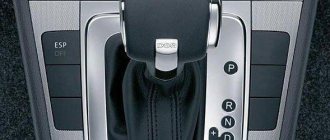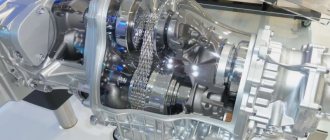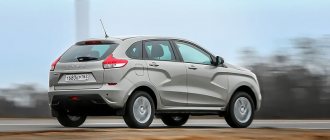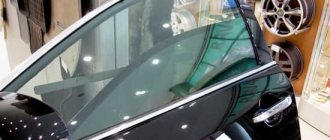Having decided to purchase a new car, many car enthusiasts are faced with the choice of whether to choose a conventional manual transmission, an automatic transmission, a CVT or a robot. Today on the automotive market you can find models that satisfy almost all of our requirements and you just need to decide what suits you best. In this article we will look at what modern automatic transmission options are offered by various manufacturers and hope that our information will allow you to make the best choice.
So, the most familiar version of a manual transmission is well known to almost all drivers. It has its pros and cons. The mechanics have diehard fans, but everything is moving forward and constantly improving. Today, an increasing number of drivers prefer cars with various types of automated transmissions. This can be explained by the simplicity and ease of operation, as well as a greater feeling of comfort from the trip. The tendency to switch from manual to automatic is especially noticeable among female drivers. In this category of drivers, a manual automatic transmission will be chosen by a very small number of drivers. But automatic machines are also different, although not everyone understands how to identify a classic automatic or CVT. This group often includes:
- classic automatic or torque converter;
- variable speed drive;
- robot.
Automatic transmission
This category most often includes torque converters, which are most widespread in the modern automotive market. The operating principle of such a system is based on the fact that the automatic transmission is filled with a special transmission fluid, which is in constant motion in a vicious circle. This is achieved by constant pressure, which creates an oil flow that produces torque.
Like any other gearbox mechanism, the automatic is constantly being improved. If in the first years of the appearance of such automatic transmissions, the devices had 4 stages, today the most common automatic transmissions are those with 6, 7, and sometimes 8 gears. Such transmissions have a number of advantages, but along with this they also have significant disadvantages.
Advantages of an automatic transmission
- The car is much easier to drive in urban environments.
- Having an automatic transmission will make it more difficult to stall on the road, but if this happens, it will be impossible to get out of the problem area with the help of “swinging”.
- The automatic makes it easier to start on slippery roads, eliminating the possibility of slipping.
- The possibility of engine overheating is excluded.
- The transition from one gear to another is very smooth and is almost not felt in the cabin.
- Electronics are able to adapt to individual driving style.
Minuses
- Quite a high price for car models with automatic transmission.
- Automatic transmissions require high costs during maintenance or repair.
- The automatic transmission requires strict control over the level of transmission fluid. You can only replace it with an original or an approved analogue, which is also not cheap.
- Higher fuel consumption compared to conventional mechanics.
- A car with such an automatic transmission cannot be towed over long distances.
- The overclocking process is often not very good.
How does a manual transmission work?
The mechanics are simple. The body contains:
- primary, secondary, intermediate shafts with gears, additional shaft and reverse gear;
- synchronizer clutches;
- differential;
- crankcase;
- gear shift rod and fork;
- crankcase (half filled with transmission fluid).
On top of the box there is a gear selection mechanism with locking and locking devices. The gear shift lever is located in the cabin and is capable of moving in the longitudinal and transverse directions.
During operation, torque from the engine is transmitted through the clutch to the input shaft. The rotation speed is converted by the helical gears and then transmitted to the wheels. If the gear increases torque, then the engine speed decreases (and vice versa). In the classic case, 2 or 3 shafts are used for this.
The selection of the desired pair of gears to transmit the required torque under certain driving conditions is done using shift forks, which are driven by a selector.
Manual transmission
The following malfunctions are typical for manual transmissions:
knocking noise when driving and changing gears;
impossibility or difficulty of switching on speeds;
oil leak from the crankcase;
spontaneous switching off of gears.
Such problems arise due to wear of gearbox parts, loosening of fixing bolts and nuts, so a car with manual transmission requires timely maintenance.
Variable speed drive
This is a more modern automatic transmission model that operates on a slightly different principle.
Classic mechanics and a CVT can sometimes be quite difficult to distinguish even for very experienced drivers, and not everyone understands well how a CVT differs from an automatic transmission. Visually, these are often very similar shift levers, but the operating principle of both mechanisms is significantly different.
The variator has two disks or pulleys, with a belt or, in rare cases, a chain stretched between them. When moving, these pulleys move or move apart, thereby changing the gear ratio. The difference between a CVT and an automatic is the fact that it has no gears at all. This mechanism was developed with the following goal: to make the transition from one speed to another as smooth as possible, which results in the absence of a power gap. The driver and passengers of the car receive maximum comfort from traveling in a car with a CVT, which is ensured by an amazingly smooth ride. Operating such a gearbox is almost no different from operating a classic automatic transmission. The variator has its obvious advantages, but, unfortunately, this is not an ideal option at all and designers still have a lot of work to do to eliminate a number of shortcomings. The following points can be considered as the pros and cons of the variator:
Advantages of CVTs
- Completely smooth ride for a comfortable ride.
- Fast acceleration, which is ensured by the fact that the torque is always at its peak, due to its design.
- The weight of the mechanism is very light.
- Saving in fuel consumption.
Disadvantages of CVTs
- Not suitable for those who like aggressive driving with sudden starts and frequent slipping.
- This device must not be loaded onto trailers or towed.
- The CVT is a rather noisy device, which is very noticeable in the cabin.
- The service life of the variator is somewhat shorter than that of a conventional automatic transmission.
- It has a fairly high cost of repair and maintenance. Sometimes it can be extremely difficult to find a workshop that can carry out high-quality repairs of this mechanism.
- A CVT requires lower production costs, but the service life is also much shorter compared to a classic automatic.
Automatic transmission operation
A classic automatic transmission consists of:
- torque converter (clutch);
- planetary gearbox;
- hydraulic system;
- electronic control unit.
The automatic transmission works as follows:
- When the engine starts, the oil pump is activated to create liquid pressure in the AT.
- The pump wheel of the torque converter spins up at the speed of the crankshaft (the turbine and reactor wheels are stationary at this time).
- The driver presses the gas pedal and changes gears. The engine spins together with the pump wheel, from the blades of which oil is thrown towards the turbine, causing it to rotate. The lubricant then returns to the pump wheel and speeds it up.
- The oil passes through the machine's radiator.
- Free disks and gears rotate in a planetary gearbox (fixed clutches are attached to the box body).
- The electrical unit determines the vehicle speed and the load of the power unit based on sensor readings and transmits a signal to change gears to the valve body. The oil pump then supplies operating pressure to the hydraulic system channels.
- From the oil pump, the technical fluid passes to the valve body, the solenoid opens, passing it to the planetary link. The liquid presses on the pistons, compressing the friction discs.
- An element of the planetary gear, rigidly connected to the clutch (for example, a crown), is blocked; torque is transmitted through the carrier or sun gear. The rotation speed and transmitted force of the output shaft changes. At the same time, the elements of the previous transmission of the machine are unlocked.
Automatic transmissions with manual control mode (Autostick, Tiptronic) allow the driver to independently adjust the speed limit, but the switching process itself occurs under the control of the electric unit.
What machine malfunctions occur most often?
Malfunctions of the machine are expressed in the inability to switch gearbox operating modes or in the blocking of one of the gears. The causes of breakdowns may be in the mechanical and electronic parts of the automatic transmission. This:
Automatic transmission
malfunction of the torque converter and automatic locking clutch;
wear of shafts, gears, friction elements;
clogging of oil channels;
failure of the valve body and oil pump;
failure of the machine's actuators, control system sensors or controller;
breaks, short circuits in the electrical wiring of the machine.
The service life of the machine depends on the nature of the vehicle’s operation, timely and competent maintenance. In accordance with the recommendations of the vehicle manufacturer, it is necessary to periodically change the oil and regularly undergo diagnostics at a service station to monitor the condition of the oil receiver and radiator.
Robot
A robotic gearbox is an attempt by designers to combine a manual transmission with an automatic transmission. The principle of operation of this device is that it is almost no different from the principle of operation of mechanics, but the speeds are switched automatically by a special control unit on a servo drive. Here the driver will feel the usual pause at the moment of switching and a number of other obvious signs of “mechanics”. In addition, this gearbox provides the ability to switch to full manual control. Today such a box can be found on cars of any class, from budget to premium.
The difference between automatic transmission and manual transmission
There are visual differences between the transmissions. When buying a car, you can see them even without reading the documentation. Just look at the gearshift lever. If there is a “P” position at the top, i.e. parking, this is an automatic transmission. The robot only has "N" and "R". But the motorist is mainly interested in their efficiency and economy.
Automatic transmissions appeared back in the 1930s, when the Cadillac brand began using them. They are not the same age as DSG, but still they cannot be called a new product. And the problem is that motorists associate them with outdated technology, while robots are associated with technical progress. However, automatic transmissions are also evolving.
The features of the technical solution are such that the design of the box includes a torque converter, which acts as a clutch, a connecting link between the engine and the gearbox.
Automatic and robotic gearbox in a car.
For a long time there was a problem in his work. Due to the difference in the speed of rotation of the pump and turbine wheels, when the fluid flow accelerated, it became very hot and the efficiency due to the torque converter decreased.
For this purpose, a blocking mode was invented, but at first it did not solve the problem.
In automatic transmissions, this is done electronically, so this device has now become much more reliable. And if previously only 4-speed automatic transmissions were produced, then new cars are even equipped with 8- and 9-speed gearboxes.
From a design point, a robotic gearbox is a variant of a mechanical transmission, the only difference is the absence of 3 pedals. The clutch is released through an electric drive (or actuator).
This option differs from an automatic transmission in its simpler design, i.e., theoretically, it is more reliable. But it is not so. The simplicity of the design only led to the fact that robots became cheaper to produce and quickly began to appear even on inexpensive models. The difference between the transmissions was still significant.
The robotic version, especially with fairly active driving, could not provide smooth gear shifting. Because of this, the jerky movement greatly irritated drivers. In addition, delays when changing stages were added to this.
Diagram of a robotic gearbox.
Engineers from large automakers are working to solve the problem. This is how preselective robots appeared, the most popular of which is the development of the Volkswagen concern - the DSG model, which is a system of 2 boxes with the corresponding number of clutches. 1 gearbox is needed for even gears, 2 for odd ones. Switching is carried out accurately and quickly, and the driver does not experience discomfort.
What is better to choose
As you can already understand from the article, each type of transmission has its own pros and cons, and the choice must be made based on your personal capabilities and needs.
- If you prefer comfort and leisurely driving, then you should choose a car equipped with a CVT.
- For those who like reliability and frequent changes of car, a classic automatic is suitable. Cars of this type are the most popular in today's car market.
- An automatic robot with one disc can be a good solution for car enthusiasts who have limited financial resources but want to purchase a car with an automatic. Despite the low level of comfort, the motorist receives an inexpensive car with economical fuel consumption.
A robot with two disks should only be purchased new. When buying a used car, the owner must be prepared to soon replace or overhaul the robotic box, which means significant costs.
Comparative characteristics of types of gearboxes
| Type of gearbox | Options | Resource (km) | Economical | Exploitation | Advantages | Flaws |
| Hydromechanical automatic | Depending on multi-stage | About 500,000 | High fuel consumption | Automatic is the best option for driving around the city (especially in traffic jams) | Versatility Ease of operation Large off-road capability Reliability Protection of the engine and chassis from overloads Maintainability | Slow acceleration Expensive maintenance |
| Variable speed drive | Weight 40-60 kg | On average 220,000 - 240,000 | Low fuel consumption | Driving around the city and on the autobahn | Quick acceleration Improved traction and no jerking during acceleration Smooth ride A large number of options for changing the gear ratio | The variator requires the use of special oil Cannot be repaired High maintenance costs Noise from operation is noticeable in the cabin |
| Robot | Depending on the drive, speed switching | Up to 250000 | Low fuel and oil consumption | Roads with good hard surface | Long service life Maintainability Low cost | Delay when switching gears Reduced service life when driving in traffic jams Clutch overheating Jerks and jerks when switching |
| Mechanics | Depends on the number of steps | Average 500000 | Average fuel consumption Low - oil | City limits Autobahn Off-road | Good acceleration High efficiency Quick winter starting Durability Unlimited towing and fast driving capabilities Low price | Difficulty of operation Possible overloads Constant use of the lever and pedals When starting, the car rolls back |
If you look at the table, which box do you think is better? Write in the comments.
